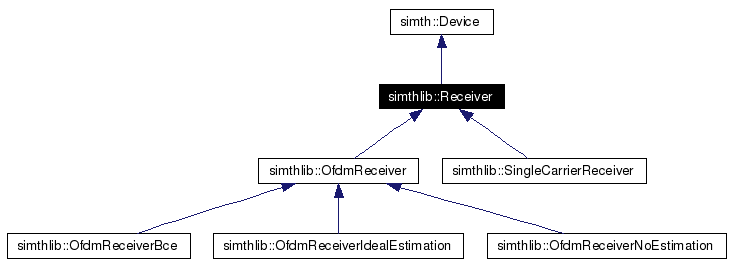
#include <receiver.h>
Inheritance diagram for simthlib::Receiver:

Public Member Functions | |
| Receiver (int deviceID, simth::DeviceSystemIntf *system, const simth::PropertyList &pl) | |
| virtual | ~Receiver () |
| virtual void | process () |
| virtual void | updateInputLengths () |
| virtual void | updateOutputLengths () |
| virtual void | receiveSignal (const simth::TimeSignal &SignalSamples_ptr, simth::ModSeq *modSeq, double *noise=NULL, simth::ModSeq *trans=NULL)=0 |
| virtual void | print (std::ostream &os) const |
| virtual void | startOfSimulation () |
Static Public Member Functions | |
| static void | init (const std::string fileName, simth::Device **dev, simth::DeviceSystemIntf *sysPtr, int ID, const std::string ®ionQualifier="") |
| static simth::Device * | findChannel (simth::DeviceSystemIntf *sys) |
Protected Member Functions | |
| virtual int | numTimeSamples (int numModSymbols) const =0 |
| virtual int | numModSymbols (int numTimeSamples) const =0 |
Related Functions | |
| (Note that these are not member functions.) | |
| propertylist_Receiver (not_a_function) | |
The class receiver is an abstract class which provides an interface for transforming a time signal which in turn is represented by discrete (complex; since we are operating in the equivalent baseband) time samples to a sequence of complex values.
The number of modulation symbols that are required internally by the device for processing can be larger than the number of output symbols. Hence the capacity() could equal the output length as well as it could be greater than that length. That is the case if 'dummy' symbols are skipped at the end of the processing procedure.
|
||||||||||||||||
|
Class constructor. |
|
|
|
|
|
Helper function to find the channel block in this system. Returns NULL if none could be found, which means that the channel device has a higher ID than this block and you need to renumber your devices. |
|
||||||||||||||||||||||||
|
Static function that parses a file to extract the parameter values for the receeiver to be constructed. |
|
|
Returns the number of mod symbols, that belongs to the given number of time samples. Implemented in simthlib::OfdmReceiver, and simthlib::SingleCarrierReceiver. |
|
|
Returns the number of input time samples that match to the given number of modulation symbols. Note that in derived classes there must be no one-to-one mapping between the number of time samples that are returned by numTimeSamples(modSymbols) and the number of modulation symbols that are returned by numModSymbols(timeSamples). E.g. in an OFDM recevier the given number of modulation symbols could be already truncated by the number of dummy symbols. In that case this function returns the number of time samples that belongs to the complete filled OFDM blocks. Implemented in simthlib::OfdmReceiver, and simthlib::SingleCarrierReceiver. |
|
|
Reimplemented from simth::Device. Reimplemented in simthlib::OfdmReceiver, simthlib::OfdmReceiverNoEstimation, simthlib::OfdmReceiverIdealEstimation, simthlib::OfdmReceiverBce, and simthlib::SingleCarrierReceiver. |
|
|
Implements simth::Device. |
|
||||||||||||||||||||
|
Transform samples of a signal to a sequence of complex Symbols. Implemented in simthlib::OfdmReceiver, and simthlib::SingleCarrierReceiver. |
|
|
Reimplemented from simth::Device. Reimplemented in simthlib::OfdmReceiver. |
|
|
Implements simth::Device. Reimplemented in simthlib::OfdmReceiver. |
|
|
Implements simth::Device. Reimplemented in simthlib::OfdmReceiver. |
|
|
These are the properties of class Receiver . This list is auto-generated from the XML-Devicelist of this device by means of an XSLT transformation script. Description of this device in the XML file: Abstract base class of a receiver. Note that this class also has the Properties of its base classes. The direct base class is simth::Device ; direct link to its propertylist should be propertylist_Device(). The list below usually includes the properties that have been inherited from the base classes; the properties which belong only to this class can be found at the end of this list.
|
 1.4.1
1.4.1